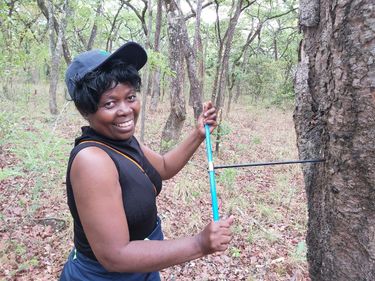
Scipioni, M. Marcelo Scipioni
Sessions in which Scipioni, M. Marcelo Scipioni participates
Thursday 30 June, 2022
Dendrochronological archives in the tropics of the Americas have been under-studied for a long time. Some of the challenges include the Identification of tree-ring boundaries in certain tree species, absence of winter dormancy associated to low temperatures in most of the cases, and logistic difficulties of fieldwork in remote sites. However, part of the slow progress is also related to the fact that historically much less resources have been inv...
Araucaria angustifolia is an endangered species that occurs in the high and cold regions of southern Brazil. This species has economic importance due to its wood and seeds, as well as playing a fundamental ecological role for the southern fauna and flora. Climate change can affect it sdistributional area and conservation, making it urgent to investigate the effect of climate on its development. The objective of our study was to investigate how growth rates of A. angustifolia vary in relati...
Sessions in which Scipioni, M. Marcelo Scipioni attends
Monday 27 June, 2022
Blue Intensity (BI) is a cost-effective analytical method for measuring relative wood density in the rings of conifer tree species. Since early concept papers in the 1990s/2000s, there has been a recent explosion in the application of this method for both dendroclimatology and historical dating as well as other dendro-disciplines. The beauty of BI is that the analytical costs, mainly related to the cost of a h...
Blue Intensity (BI) is a cost-effective analytical method for measuring relative wood density in the rings of conifer tree species. Since early concept papers in the 1990s/2000s, there has been a recent explosion in the application of this method for both dendroclimatology and historical dating as well as other dendro-disciplines. The beauty of BI is that the analytical costs, mainly related to the cost of a h...
Tuesday 28 June, 2022
Africa is faced with a number of challenges including climate change and ecological disturbance due to various anthropogenic activities. These problems adversely affect the forests and also ecosystem services. My appreciation for the forests motivated me to pursure my undergraduate studies in Forestry. I first applied dendrochronology during my PhD research which focused on understanding the climate change vulnerability of the Zambezi teak forests in Zambia. However, lack of research facil...
Tree-ring time series provide long-term, annually resolved information on the growth of individual trees. However, public tree-ring archives contain a considerable portion of data collected from trees that have been selected with specific research questions in mind (e.g., for climate reconstruction). This makes these archives a biased representation of the sensitivity of forest ecosystems to ongoing climate variation (e.g. temperature, precipitation), including non-stationarity (i.e....
Tree-ring research studies depend heavily on samples, but the connection to the sampling theory remains loose. Tree-ring studies need to be based on samples of restrained size for several reasons: measuring tree-ring features remains labour-intensive, costly, and sampling cannot be seen as totally free of consequences for trees. Sampling, the art of selecting observational units to produce population-level estimates, comes with constraints that, when not respected, lead to biases and loss ...
Forest responses to climate change are highly uncertain, but critical for forecasting and managing forest carbon dynamics. Tree-ring time series data provide annually resolved growth responses to climate, but often lack the stand-level information needed to scale growth up to carbon uptake. In contrast, the U. S. Forest Service Forest Inventory and Analysis (FIA) Program is an exceptional spatial network to estimate forest carbon, but lacks the annual resolution needed to determine how tre...
Forest disturbances and tree growth are major drivers of dynamics and long-term carbon storage in forests. Combining forest inventory data and tree-ring analysis allows for a retrospective estimate of aboveground forest biomass (AGB) and disturbance dynamics at decadal to centennial scales, both being directly related to net primary productivity (NPP). We used this combined approach to estimate precisely-dated ages of aboveground carbon in over 20 temperate old-growth forests in Western Eu...
Past forest mortality after disturbances creates one source of uncertainty that needs to be taken into account to reconstruct biomass dynamics. Additionally, using unitless normalized data from tree-ring records to calibrate stand productivity in vegetation models constitutes another source of uncertainty for model calibration. In this presentation I would assess these two sources of uncertainty and discuss the influence of calibration technique in model-data fusion. I combined data from p...
Tree-ring time series provide long-term, annually resolved information on the growth of individual trees. When sampled in a systematic context, tree-ring data can be scaled to estimate the forest carbon capture and storage of landscapes, biomes, and ultimately the globe. A systematic effort to sample tree rings in national forest inventories would yield unprecedented temporal and spatial resolution of forest carbon dynamics, and help resolve key scientific uncertainties, which we highlight...
Tree-ring time series provide long-term, annually resolved information on the growth of individual trees. However, public tree-ring archives contain a considerable portion of data collected from trees that have been selected with specific research questions in mind (e.g., for climate reconstruction). This makes these archives a biased representation of the sensitivity of forest ecosystems to ongoing climate variation (e.g. temperature, precipitation), including non-stationarity (i.e....
As of 2020, 56% of the world’s population live in urban areas. These individuals benefit from numerous ecosystem services provided by urban forests, including urban heat island mitigation, energy use reduction, stormwater interception, wildlife and pollinator habitat provision, air pollution removal, and carbon sequestration. Urban greenspaces are also often the most accessible avenue for exposure to the natural environment, providing additional aesthetic, recreati...
Tree rings have long been used to monitor forest change by measuring differences in tree ring widths through time derived from a representative sample of forest trees. However, for many reasons, tree rings have only rarely been utilized to monitor urban forest change. Urban forest change monitoring has more commonly occurred with time-series of remote sensing imagery, such as yearly stacks of Landsat satellite imagery converted to some vegetation index or other proxy. Tree rings and remote...
Wednesday 29 June, 2022
Dendrochronology is considered one the most precise of all the scientific dating techniques. However, it requires long sequences of tree rings and a master record for both the species and region in question. At the University of Groningen, we have been pioneering a new approach to dating that combines the precision of dendrochronology with the versatility of radiocarbon dating. It relies on the detection of spikes in the annual radiocarbon record, thought to b...
Information garnered from historical timbers and wooden artifacts (e.g. houses, barns, ships) can greatly enhance our understanding of human, ecological, and climate history, especially in regions where few old-growth forests and trees remain, tree longevity is relatively short (less than 300-400 years), and environmental conditions break down wood rather quickly, like in mesic to wet regions. Over the last decade plus, the application of tree-ring techniques on wo...
Current and projected changes in climate are estimated to be from 10 to 100 times faster than the natural adaptive capacity of trees whose generation times are long. As extreme climatic events are becoming more frequent and exert a strong selection pressure on tree populations, there is an urgent need to better characterize the genetic variability involved in the response of trees to climate. There is currently a lack of knowledge on the role of genetic variability in tolerance to climatic...
Climate change threatens forest trees. Their ability to resist depends on their potential to adapt. Phenotypic plasticity, i.e. the potential for individual adaptation, is a rapid mechanism that can allow trees to adjust to new climatic conditions. Tree-rings allow retrospective estimation of phenotypic plasticity of wood formation to climate in forest trees. In this study we show how to estimate linear reaction norms of annual ring variables as a function of climate. We use the slope of t...
Information garnered from historical timbers and wooden artifacts (e.g. houses, barns, ships) can greatly enhance our understanding of human, ecological, and climate history, especially in regions where few old-growth forests and trees remain, tree longevity is relatively short (less than 300-400 years), and environmental conditions break down wood rather quickly, like in mesic to wet regions Over the last decade plus, the application of tree-ring techniques on woo...
It has been shown that trees get older in the wet tropics, but the mechanisms behind this observation are still not clear. Literature shows that moisture could directly affect longevity by modulating physiological processes of trees. Other studies point to the potential role of water on tree size, which could indirectly affect longevity if one reconciles to the fact that the growth rate of tropical trees doesn’t differ significantly between wet and dry sites. The third group points to the ...
Increasing frequency of droughts strongly affect the available soil water. Lower water availability was often reported to reduce radial growth not only in climate-limited, but also in optimal areas of tree species distribution. Sampling strategies in dendrochronology focus on specific sites, often in climate-limited conditions. Using tree ring samples collected within National Forest Inventories provides an opportunity to assess growth-climate responses statistically representative o...
Spatially-resolved climate field reconstructions are ideal for analyzing spatial anomaly patterns and characterizing regional-scale trends resultant from climate change. To date, few fine-scale, spatially-resolved paleotemperature datasets exist in the Northern Hemisphere. Here, we present a 2.5x2.5o temperature field reconstruction of warm season (April-August) mean surface air temperatures, developed from a network of 130 tree-ring chronologies. In the reconstruction’s current form, stat...
Rescheduled from June 28th to June 29th
Thursday 30 June, 2022
How old are tropical trees? This fundamental question has long driven the curiosity of laymen and scientists. But only recently, a great number of studies conducted by many brave dendrochronologists resulted in a significant tree-ring-based knowledge that allows us to start accurately estimating tree ages across the globe. As science goes, not only knowing the longevity of tropical trees is essential to understanding forest dynamics and its role in biogeochemical cycles, but one must also ...
The state of fragmented populations of tree Polylepis genus heavily impact by human activities leads to the need to conduct ecological studies to better understand their vulnerability. We evaluated the newly identified tree species Polylepis rodolfo-vasquezii, endemic to central Peruvian Andes, distributed from 3700 to 4750 m a.s.l. and suitable for dendrochronological studies. Our objectives were twofold: (1) to determinate age population in both forests and developed linear models that c...
In the tropical Andes several species of the genus Polylepis have been reported to be useful to record climate variability using tree-ring width, expanding the geographical distribution of proxy records into the tropical region. However, in the tropics classical dendrochronology based on ring-width patterns is often challenging, hampering the development of climate reconstructions. Alternative methods can confirm annual periodicity of tree rings, and help on extracting more reliable climat...
Given the short span of instrumental hydroclimatic records in the South American Altiplano, longer time records are needed to understand the nature of climate variability and to improve the predictability of precipitation, a key factor modulating the socio-economic development in the Altiplano and adjacent arid lowlands. In this region growths P. tarapacana, a long-lived tree species being very sensitive to hydroclimatic changes and widely used for tree-ring studies in central and southern...
Polylepis tarapacana is the longest paleoclimatic tree-ring archive in the South American southern tropics. It grows up to 5200 m a.s.l. in the South American Altiplano, a semiarid-high elevation Andean Plateau. P. tarapacana ring-widths (RW) have provided centuries of past hydroclimate information, but the potential use of tree-ring stable isotopes for paleoclimatic or ecophysiological studies remained understudied for this species. Here, we developed a network of four RW, oxygen (δ18O) a...
Araucaria angustifolia is an endangered species that occurs in the high and cold regions of southern Brazil. This species has economic importance due to its wood and seeds, as well as playing a fundamental ecological role for the southern fauna and flora. Climate change can affect it sdistributional area and conservation, making it urgent to investigate the effect of climate on its development. The objective of our study was to investigate how growth rates of A. angustifolia vary in relati...
A gap of millennial tree-ring data suitable for dendroclimatology has long been evident in the North American boreal forest. In my talk, I will describe the adaptive approach we have developed to build and improve a data network for millennial dendroclimatology in the eastern Canadian taiga. Recurrence of stand replacing wildfires is the most important constrain to the elaboration of long tree ring chronologies, which can only be developed away from regions ...
The interpretation of stable isotopes in a dendroecological framework can provide powerful insights into how trees adjust physiologically in response to the environment. This symposium aims to bring together researchers who use stable isotopes in tree rings to address ecophysiological responses to environmental changes from intra-annual to multi-decadal resolution. We hope this symposium will enable fruitful discussions and new ideas a...
Allies have emerged as key enablers of diversity and inclusivity initiatives in the workplace, in professional associations, and in everyday life. But what is an ally? What skills are required to be an effective ally? How do we hold ourselves and our community members accountable for being effective allies? This symposium will provide a deeper understanding of what it means to be an ally and the skills to help advance allyship as individuals and as a community. Fur...
(by bus, max 92 people)Designed for visitors and newcomers, the tour is based on the pleasure...



